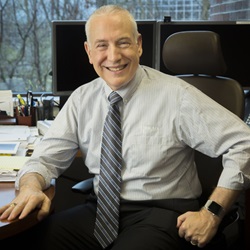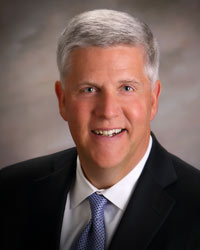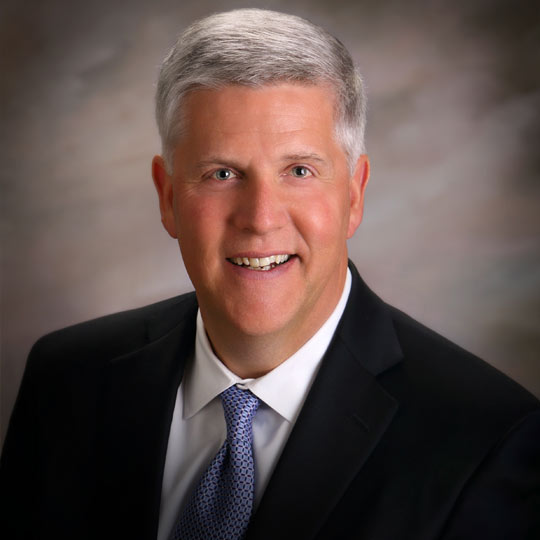Dr. Pate’s Prescription for Change
St. Luke’s Health Partners’ Dave Self looks in the rearview mirror and the crystal ball


I met Dave Self not long after I moved here to Idaho to become president and chief executive officer of St. Luke’s Health System. Dave was an insurance executive at that time. We served on a panel together and I talked about St. Luke’s plans to transform health care. Dave confessed to me years later that he thought sarcastically, “Yeah, right.”
Insurance companies have tried and failed and doctors have resisted attempts to change the business model of health care. He was not wrong to be skeptical. Dave came to realize that St. Luke’s was serious about this, making huge investments to prepare for and enable this transformation, and that we had alignment from our physicians about this vision of transformation. He became so convinced that we were committed to this transformation and might just make it happen that he joined our organization to lead our network.
Here is today’s guest blogger, St. Luke’s Health Partners Vice President and Chief Administrative Officer Dave Self, with his account of the journey we have been on and where it is likely to take us.
- David C. Pate, M.D., J.D.

Many of us get, and give, conflicting advice routinely.
Don’t live in the past.
Those that forget history are doomed to repeat it.
And so on. But for each set of contradictory recommendations, there’s usually a happy medium. In this instance, the middle ground is occupied by William Shakespeare, who noted that “What’s past is prologue.”
Which is why I believe there is value in viewing the St. Luke’s Health System journey of the past 10 years in both the rearview mirror and the crystal ball, to appreciate the foundational work, learn from work that went as planned and those efforts that weren’t as successful and build the reserves that will enable us to confidently take the next steps in the transformation. (Disclaimer: I, too, am weary of hearing the word transformation, but it really does apply here, so hang in there!)
Health care has a habit of moving slowly and then suddenly swinging way too far in a direction. A good example is how HMOs were introduced in many states, including Idaho, during the 1990s.
HMOs were aimed at reducing costs with a ‘service-by-permission’ system of authorizations by insurance companies. I was part of the Idaho health insurance industry during that time, and while we had good intentions, HMOs failed, because the underlying assumption was that we would tell physicians, hospitals and other providers what they could do, and often, when X procedure or service could be performed.
The docs were not having it, and eventually, neither were patients. This was definitely a learning opportunity for the industry.
Fast forward to about 10 years ago, when St. Luke’s stated that it was setting out to transform health care.
I was not wearing a St. Luke’s jersey then. I presumed that the effort would be HMO-like and fail, or possibly that it was a marketing approach designed to differentiate the organization from other providers.
I was wrong.
Unless you were inside St. Luke’s at that time, it was difficult to understand the work underway: developing the thought leadership required for meaningful change; bringing along key executives, boards and committees; creating a roadmap for the organization to follow; aligning the resources required for the heavy lifting to come; and presumably, a whole lot of lively debate around the need to change and the timing. In hindsight, and again based on the perspective of someone who came aboard some years later, it’s clear that a ground rule was to avoid command-and-control care in favor of a model where patients, providers and payers could be aligned around best outcomes and lower costs.
Meanwhile, health care continued to change. Costs and utilization continue to increase. The Affordable Care Act was signed and implemented. Idaho created its own health insurance exchange. St. Luke’s looked around and did not find a partner organization in the market interested in transforming health care along the lines the organization envisioned and invited a new player to the market. Other new players, insurance products and regulations all impacted a rapidly changing landscape.
By 2015, the goals of improving health outcomes and reducing the total cost of care was becoming a more common topic at St. Luke’s – and St. Luke’s Health Partners was developing as the vehicle for introducing value-based health care to the market in a meaningful manner.
On Jan. 1, 2017, St. Luke’s Health Partners went to market as a financially and clinically integrated network focused on aligning the incentives between consumers, healthcare providers and payers. This alignment means that St. Luke’s Health Partners takes accountability for improving health outcomes, and ultimately, reducing the total cost of care. Simply put, St. Luke’s Health Partners is bound to improve specific health outcomes on a fixed budget.
Now in our third year, St. Luke’s Health Partners serves more than 182,000 Idahoans, will represent more than $1 billion in healthcare spending by the end of 2019 and partners with five commercial insurance companies and the federal government to deliver value-based care.
The work is far from complete, but we are seeing evidence of improved health outcomes and progress made to temper the trends driving the costs of care and health insurance, and we are working diligently to engage, support and empower our network providers to provide the care they believe is best for patients. This is a long game, and we’re just in the top of the first inning.
What’s next?
At this point, we envision a future in which we deliver providers an increasing amount of real-time information and a more complete picture of patients. These data and business intelligence capabilities are going to be pivotal differentiators for us and the significant edge that propels our ongoing transformation (I told you to hang in there; you were warned!).
We also know that translating our progress to lower insurance premiums requires both a more efficient business model inside St. Luke’s Health System and ever-closer relationships with the insurance companies that create insurance benefit plans, set premium rates and sell policies.
St. Luke’s is committed to these achieving important goals and at the same time, recognizes that what we are operating in is not a stable, predictable environment. This is why it is vital for us to remain focused but flexible enough to refine strategies in response to consumers, healthcare providers and the needs of our communities.
Not learning from history is just a trip through the past darkly. Living in the past can make one fear the future. It’s a privilege to be part of a team that creates a vision for healthier people and healthier communities with the wisdom that comes from lessons learned.
No crystal ball required.
About The Author

Dave Self is chief administrative officer for St. Luke’s Health Partners, based in Boise, Idaho.


